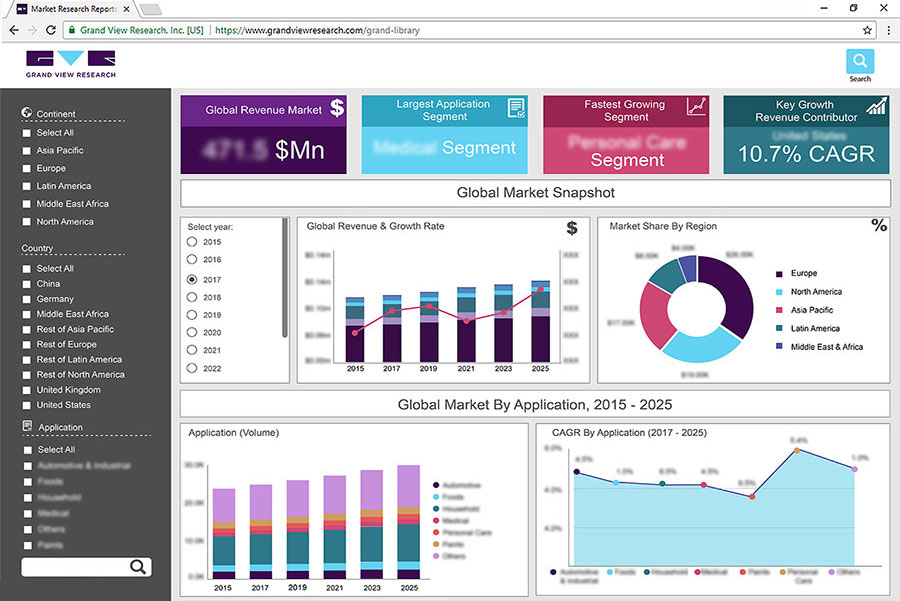
Surgical Helmet Market Size, Share & Trends Analysis Report By Product (Powered Surgical Helmets), By Application (Orthopedic Surgery), By End-use (Hospitals), By Distribution Channel, By Region, And Segment Forecasts, 2025 - 2030
- Report ID: GVR-4-68040-488-6
- Number of Report Pages: 115
- Format: PDF, Horizon Databook
- Historical Range: 2018 - 2023
- Forecast Period: 2025 - 2030
- Industry: Healthcare
Surgical Helmet Market Size & Trends
The global surgical helmet market size was estimated at USD 79.50 million in 2024 and is projected to grow at a CAGR of 4.77% from 2025 to 2030. The growth can be attributed to the high volume of surgical procedures and the increasing number of road and sports accidents. For instance, according to data published by the National Safety Council, the U.S.-based safety advocate nonprofit organization, around 46,027 individuals died in motor vehicle crashes in the U.S. in 2022. Thus, the large number of road accidents is anticipated to boost the demand for surgical helmets in the coming years.
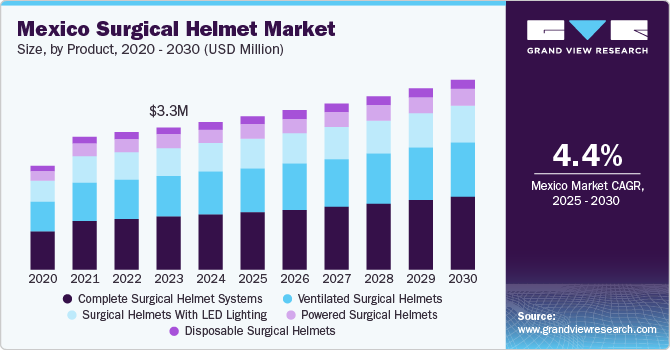
In addition, data released by Transport Canada in May 2024 reveals that in 2022, there were 1,931 motor vehicle fatalities, marking a 6.0% increase from 2021 (1,821) and the second-highest number recorded in the past decade. The total number of injuries also rose to 118,853 in 2022, a 9.5% increase compared to 108,552 in 2021. The rise in road accidents is expected to result in a higher incidence of orthopedic injuries, which is anticipated to drive the demand for surgical helmets in the coming years.
Furthermore, the growing number of orthopedic procedures are anticipated to drive the demand for surgical helmets over the forecast period. An article published by the American College of Rheumatology in February 2024 reports that approximately 790,000 total knee replacements and 544,000 hip replacements are performed annually in the U.S., with these figures continuing to rise as the population ages.
Moreover, surgical helmets are utilized during orthopedic procedures to reduce the risk of deep wound infections by preventing skin and other particles from the surgeon's face from contaminating the open surgical site. It also protects the surgical team from potential exposure to infectious blood splashes and aerosols generated by power tools during the procedure. Thus, the growing number of orthopedic surgical procedures is anticipated to drive the market growth over the forecast period.
Market Concentration & Characteristics
The market growth stage is low, and the pace of growth is accelerating. The surgical helmet market is characterized by a high degree of growth owing to the rising number of surgical procedures, the growing number of road accidents, and the advancements in surgical helmets.
Companies are increasingly integrating advanced features and designs into surgical helmets, with several industry leaders launching innovative products. For example, in January 2021, Stryker introduced the T7 Surgical Helmet, a next-generation personal protection system for surgeons. This helmet is designed to keep surgeons cool and comfortable while ensuring effective protection during procedures. It is the lightest and quietest model from Stryker, offering a 40% reduction in noise compared to its predecessor. The helmet’s foam conforms to the user's head, providing a more comfortable fit, while its improved balance and ergonomic design enhance comfort and stability. In addition, the dual adjust knobs allow users to customize the helmet's height and width, and the optimized center of gravity helps reduce neck strain. A pause button enables users to control the fan and conserve battery life, making the helmet easier to put on and remove. These innovations are expected to drive significant market growth in the coming years.
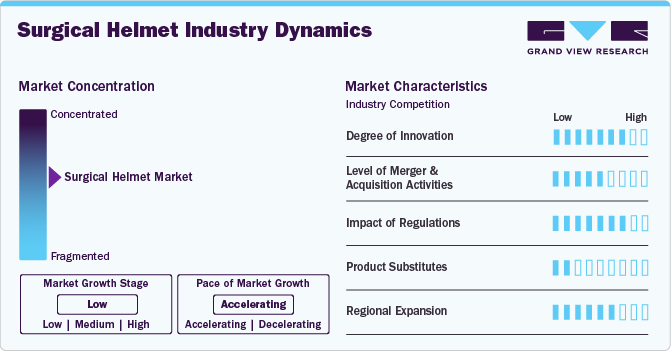
Several national and international regulatory authorities regulate surgical helmets. For instance, the U.S. Food and Drug Administration (FDA) regulates surgical helmets under the following guidelines:
-
Premarket review: Surgical helmets are reviewed by the Office of Surgical and Infection Control Devices (OHT4) and Infection Control Devices (DHT4C)
-
Submission type: Surgical helmets are 510(K) exempt.
-
Regulation number: Surgical helmets are regulated by 878.4040.
-
Device class: Surgical helmets are Class 1 devices.
Several products can serve as alternatives to surgical helmets. These substitutes include face shields and surgical masks with attached face shields, which offer basic protection against splashes and particles during surgical procedures.
Product Insights
The complete surgical helmet systems segment dominated the market and accounted for the largest revenue share of 36.40% in 2024. This dominance and growth of the segment can be attributed to the increasing launches of products and growing demand for personal protective equipment to reduce the risk of cross-contamination and infection during surgical procedures.
The ventilated surgical helmets segment is expected to experience the fastest growth over the forecast period. This growth can be attributed to several key advantages, including enhanced ventilation that helps prevent overheating during long or complex surgical procedures. These helmets have a built-in ventilation fan that helps keep surgical staff cool and comfortable, even during critical operations. In addition, the advanced aeration system in these helmets circulates air in four distinct directions, ensuring optimal airflow while minimizing noise levels. This combination of comfort, cooling, and quiet operation is crucial in maintaining focus and efficiency in the operating room. Due to these benefits, ventilated surgical helmets are anticipated to drive significant demand in the coming years, contributing to the segment growth.
Application Insights
The other surgery segment dominated the market and accounted for the largest revenue share of 26.43% in 2024. This segment's dominance and growth are driven by the increasing number of diverse surgical procedures, including pediatric, maxillofacial, gynecologic, and ophthalmic surgeries, among others. The rising frequency of these surgeries contributes significantly to the demand for surgical protection gear, including helmets. For instance, according to data published by the National Library of Medicine in June 2020, about 4 million gynecologic surgeries are performed annually in the U.S. alone. As the number of such procedures continues to rise, driven by an aging population and advances in medical technology, the demand for specialized surgical equipment, including protective helmets, is expected to grow over the forecast period.
The orthopedic surgery segment is projected to experience the highest compound annual growth rate (CAGR) over the forecast period, driven by the increasing prevalence of orthopedic conditions and the growing number of orthopedic procedures, such as knee, hip, and joint replacements, performed each year. According to the 2022 American Joint Replacement Registry Annual Report, data from more than 2.8 million knee and hip procedures across over 1,250 institutions in all 50 states and the District of Columbia shows a 14% year-over-year increase in procedural volume. This makes the American Joint Replacement Registry the largest arthroplasty registry in the world by volume. The significant growth in the number of orthopedic surgeries is expected to contribute to the continued expansion of this segment in the coming years.
Distribution Channel Insights
The offline segment dominated the market and accounted for the largest revenue share in 2024. This is primarily due to the established relationships between manufacturers and healthcare facilities, such as hospitals, clinics, and surgical centers, which prefer to purchase directly from suppliers or distributors. Offline channels also allow for direct interaction, where medical professionals can assess the quality, comfort, and functionality of surgical helmets before purchase. In addition, healthcare institutions value the ability to receive product demonstrations, training, and customer support in person, further bolstering the offline channel's segment growth over the forecast period.
The online segment is expected to experience the fastest CAGR of 4.81% over the forecast period. Online distribution channels are gaining increasing popularity, particularly among smaller clinics, individual practitioners, and healthcare facilities looking for greater convenience and a wider selection of products. E-commerce platforms provide easy access to a variety of surgical helmet systemoptions, often with the benefit of competitive pricing, detailed product information, and customer reviews. The ability to place orders remotely, along with fast shipping options, is appealing to practitioners who does not have easy access to local suppliers or who prefer a more streamlined purchasing process.
End-use Insights
The hospital segment is expected to dominate the market, accounting for the largest revenue share of 45.12% in 2024. It is also anticipated to grow fastest over the forecast period. This is driven by the high volume of surgeries, including complex and high-risk procedures, where infection control and staff protection are critical. With their established infrastructure and budgets, hospitals are major consumers of surgical helmet systems, prioritizing safety and sterilization. The growing emphasis on staff protection continues to fuel demand for surgical helmets in hospital settings.
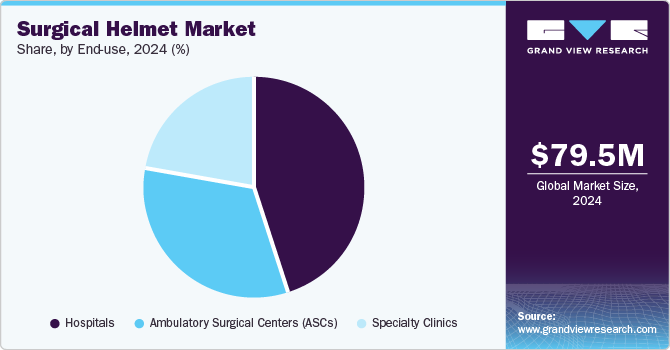
The ambulatory surgery center (ASC) segment is expected to witness significant growth in the coming years due to several factors. The increasing preference for outpatient surgeries, driven by advancements in surgical techniques and shorter recovery times, is contributing to the rise in ASC procedures. Moreover, cost-effectiveness and the growing demand for specialized, non-emergency surgeries in a more convenient, efficient setting are further boosting the adoption of surgical helmets in ASCs.
Regional Insights
North America held the largest revenue share of 40.31% in the market in 2024 due to the increasing number of surgical procedures and favorable government initiatives. In addition, the growing healthcare expenditures in the U.S. and Canada are anticipated to propel the market growth. According to the CIHI’s National Health Expenditure Database, Canada’s total health spending was expected to reach USD 247.90 billion in 2023.
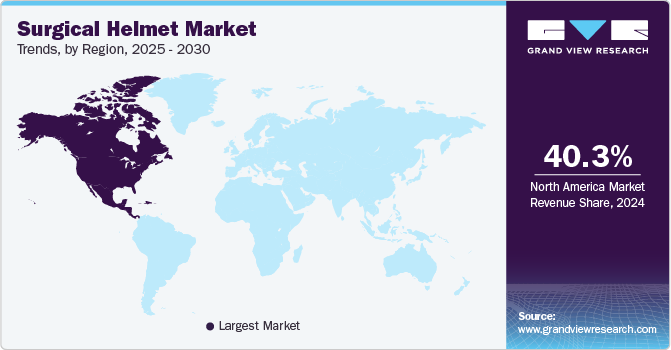
U.S. Surgical Helmet Market Trends
The surgical helmet market in the U.S. is expected to dominate the North American market over the forecast period. The presence of market players such as Zimmer Biomet, Stryker, and MAXAIR Systems is anticipated to support the country's market growth. Moreover, the growing number of road accidents and injuries across the country is expected to fuel the country's market in the coming years.
Europe Surgical Helmet Market Trends
Europe's surgical helmet market is anticipated to grow significantly in the coming years. The market is primarily driven by factors such as increased focus on patient and healthcare worker safety and technological advancements in helmet design and functionality. With an aging population and a rise in surgical volumes, demand for advanced protective equipment is anticipated to increase rapidly over the forecast period.
The surgical helmet market in the UK is expected to grow moderately over the forecast period. The growing number of road accidents and related orthopedic procedures is anticipated to support market growth in the coming years. According to the data published by the British Orthopedic Association in May 2022, in England, over 42,000 orthopedic operations were completed in March 2022, the highest number since June 2021.
France's surgical helmet market is expected to grow over the forecast period owing to the growing demand for advanced medical safety equipment in response to increased surgical volumes. Moreover, the aging population in France, which requires more complex surgeries, is expected to boost the demand for surgical helmets in the coming years.
The surgical helmet market in Germany is experiencing steady growth due to the country's robust healthcare infrastructure and the increasing focus on patient and healthcare worker safety. In addition, the growing awareness of infection control is expected to increase the adoption of surgical helmets as part of comprehensive safety protocols in operating rooms across Germany.
Asia Pacific Surgical Helmet Market Trends
Asia Pacific region is anticipated to grow significantly over the forecast period. The growing prevalence of age-related health issues and chronic diseases in countries of this region is leading to higher surgical volumes, which is boosting the demand for surgical helmets. Moreover, technological advancements in surgical helmet design, such as improved comfort and lighter materials, are expected to support the market growth.
The surgical helmet market in China is anticipated to experience significant growth over the forecast period, driven by the rising prevalence of an aging population and growing awareness of infection prevention. A study published by BioMed Central Ltd in June 2023 projects that from 2020 to 2050, the number of people aged 65 and older in China will more than double, increasing from 172 million (12%) to 366 million (26%).
The Japan surgical helmet market is projected to expand during the forecast period due to several critical factors, including an increasing number of surgeries throughout the country and a growing elderly population. According to data from the BBC, it is expected that in Japan, individuals over 65 will make up 34.8% of the population by 2040.
Middle East and Africa Surgical Helmet Market Trends
The Middle East and Africa surgical helmet market is expected to witness significant growth in the coming years due to the growing healthcare expenditure and rising demand for advanced medical equipment, particularly in the field of orthopedic surgeries. The increasing prevalence of musculoskeletal disorders, mainly due to lifestyle changes and an aging population, is contributing to a higher volume of orthopedic surgeries, such as joint replacements and spinal surgeries, which is further anticipated to boost the demand for surgical helmets.
The surgical helmet market in Saudi Arabia is expected to grow over the forecast period. The growing number of surgical procedures and rising health expenditures can boost market growth in the coming years.
The Kuwait surgical helmet market is expected to grow over the forecast period, driven by increased healthcare spending, a growing senior population, and a rising number of surgical procedures across the country.
Growing Number of Orthopedic Surgeries
The rising incidence of orthopedic surgeries, particularly joint replacement procedures such as hip and knee arthroplasties, is expected to drive significant demand for surgical helmets in the coming years. As joint replacement surgeries become more common due to an aging population and the increasing prevalence of conditions such as osteoarthritis, the need for effective personal protective equipment, including surgical helmets, grows. Surgical helmets play a vital role in ensuring both patient and surgeon safety by maintaining a sterile environment and protecting the surgical team from potential hazards. The joint replacements often involve complex and precision-driven surgeries, surgical helmets are essential for providing clear visibility, reducing fatigue, and enhancing overall performance in the operating room. As a result, the steady rise in joint replacement procedures is anticipated to contribute to sustained growth in the surgical helmet market as hospitals and surgical centers demand high-quality protective surgical helmets to meet both safety and operational needs.
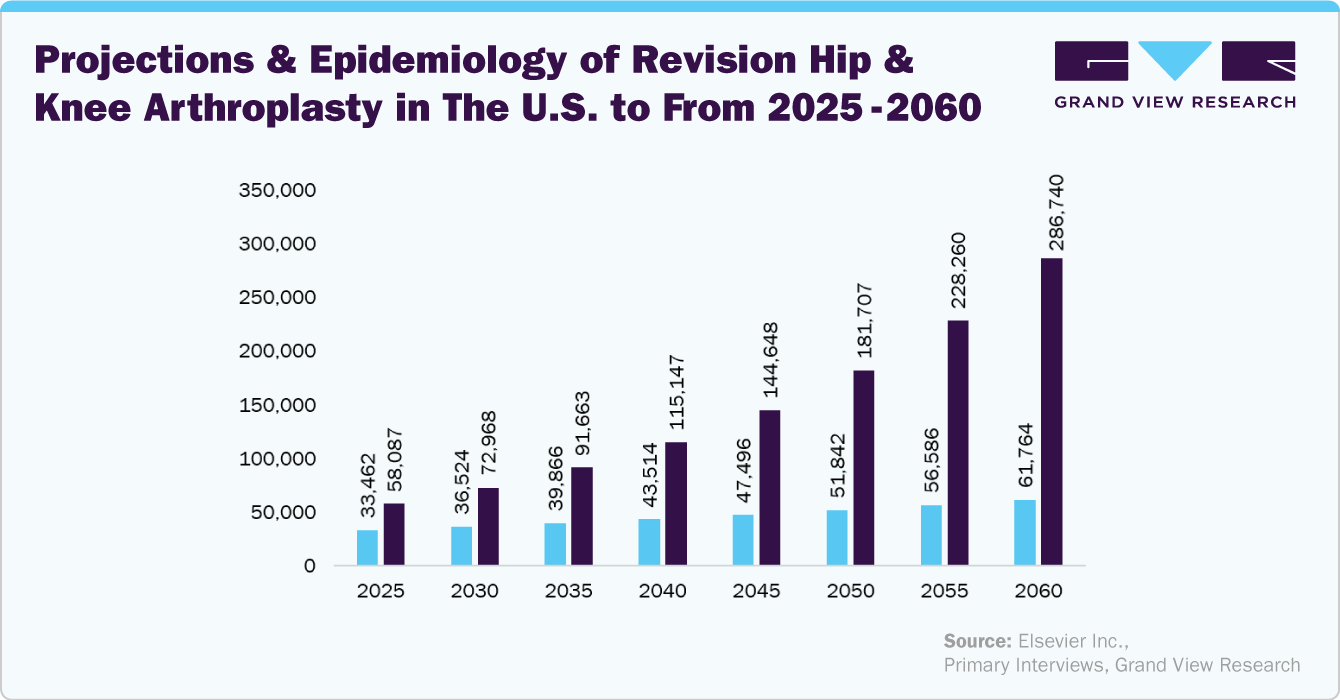
Key Surgical Helmet Company Insights
Kaiser Technology Co., Ltd., Zimmer Biomet, Stryker, Beijing ZKSK Technology Co., Ltd., THI Total Healthcare Innovation GmbH., MAXAIR Systems, MAHARANI MEDICARE PVT LTD, AresAir, Prodancy Pvt. Ltd. (Vizbl brand), and Ecolab are some of the major players in the surgical helmet market Companies operating in the industry are launching novel products and expanding their product portfolios to bolster their presence in the market. In addition, manufacturers showcase their products at various conferences and events and emphasize the global supply of their products.
Key Surgical Helmet Companies:
The following are the leading companies in the surgical helmet market. These companies collectively hold the largest market share and dictate industry trends.
- Kaiser Technology Co., Ltd.
- Zimmer Biomet
- Stryker
- Beijing ZKSK Technology Co.,Ltd.
- THI Total Healthcare Innovation GmbH.
- MAXAIR Systems
- MAHARANI MEDICARE PVT LTD
- AresAir
- Prodancy Pvt. Ltd. (Vizbl brand)
- Ecolab
Recent Developments
-
In May 2024, MAXAIR Systems, a manufacturer of surgical helmets, presented the CAPR SHS Advanced Surgical Helmet System at the 2024 AORN Global Surgical Conference & Expo. It features unmatched Outward Particulate Reduction and NIOSH-authorised filtration to help staff and patients in infection control and prevention.
-
In February 2024, Zimmer Biomet Holdings, Inc. highlighted its latest product innovations at the annual meeting of the American Academy of Orthopaedic Surgeons (AAOS) in San Francisco. Among the showcased products were implants, robotic solutions, and surgical tools, including the ViVi Surgical Helmet System. Designed to keep clinicians cool and comfortable while ensuring clear visibility for precise procedures, the ViVi system features a powerful 100,000 Lux LED light and is recognized as the quietest and lightest surgical helmet available.
Surgical Helmet Market Report Scope
|
Report Attribute |
Details |
|
Market size value in 2025 |
USD 82.84 million |
|
Revenue forecast in 2030 |
USD 104.57 million |
|
Growth rate |
CAGR of 4.77% from 2025 to 2030 |
|
Actual data |
2018 - 2023 |
|
Forecast period |
2025- 2030 |
|
Quantitative units |
Revenue in USD million/billion and CAGR from 2024 to 2030 |
|
Report coverage |
Revenue forecast, company ranking, competitive landscape, growth factors, trends, and volume analysis |
|
Segments covered |
Product, application, end use, distribution channel, region |
|
Regional scope |
North America; Europe; Asia Pacific; Latin America; MEA |
|
Country Scope |
U.S.; Canada; Mexico; UK; Germany; Italy; France; Spain; Denmark; Sweden; Norway; Japan; China; India; South Korea; Australia; Thailand; Brazil; Argentina; South Africa; Saudi Arabia; UAE; Kuwait |
|
Key companies profiled |
Kaiser Technology Co., Ltd.; Zimmer Biomet; Stryker; Beijing ZKSK Technology Co., Ltd.; THI Total Healthcare Innovation GmbH; MAXAIR Systems; MAHARANI MEDICARE PVT LTD; AresAir; Prodancy Pvt. Ltd. (Vizbl brand); Ecolab |
|
Customization scope |
Free report customization (equivalent up to 8 analysts working days) with purchase. Addition or alteration to country, & segment scope. |
|
Pricing and purchase options |
Avail customized purchase options to meet your exact research needs. Explore purchase options |
Global Surgical Helmet Market Report Segmentation
This report forecasts revenue growth at the global, regional, and country levels and provides an analysis of the latest industry trends in each of the sub-segments from 2018 to 2030. For this study, Grand View Research has segmented the surgical helmet market report based on product, application, end-use, distribution channel, and region:
-
Product Outlook (Revenue, USD Billion, 2018 - 2030)
-
Complete Surgical Helmet Systems
-
With LED
-
Without LED
-
-
Ventilated Surgical Helmets
-
Surgical Helmets With LED Lighting
-
Powered Surgical Helmets
-
Disposable Surgical Helmets
-
-
Application Outlook (Revenue, USD Billion, 2018 - 2030)
-
Orthopedic Surgery
-
Neurosurgery
-
Cardiac Surgery
-
ENT Surgery
-
General Surgery
-
Others
-
-
End-use Outlook (Revenue, USD Billion, 2018 - 2030)
-
Hospitals
-
Ambulatory Surgical Centers (ASCs)
-
Specialty Clinics
-
-
Distribution Channel Outlook (Revenue, USD Billion, 2018 - 2030)
-
Offline
-
Online
-
-
Regional Outlook (Revenue, USD Billion, 2018 - 2030)
-
North America
-
U.S.
-
Canada
-
Mexico
-
-
Europe
-
Germany
-
UK
-
France
-
Italy
-
Spain
-
Denmark
-
Sweden
-
Norway
-
-
Asia Pacific
-
China
-
Japan
-
India
-
South Korea
-
Australia
-
Thailand
-
-
Latin America
-
Brazil
-
Argentina
-
-
Middle East & Africa
-
South Africa
-
Saudi Arabia
-
UAE
-
Kuwait
-
-
Frequently Asked Questions About This Report
b. The global surgical helmet market size was estimated at USD 79.50 million in 2024 and is expected to reach USD 82.84 million in 2025.
b. The global surgical helmet market is expected to grow at a compound annual growth rate of 4.77% from 2025 to 2030 to reach USD 104.57 million by 2030.
b. The complete surgical helmet systems segment dominated the global surgical helmet market and accounted for the largest revenue share of 36.40%.
b. Some key players operating in the surgical helmets market include Kaiser Technology Co., Ltd., Zimmer Biomet, Stryker, Beijing ZKSK Technology Co., Ltd., THI Total Healthcare Innovation GmbH., MAXAIR Systems, MAHARANI MEDICARE PVT LTD, AresAir, Prodancy Pvt. Ltd. (Vizbl brand), and Ecolab.
b. Key factors driving the market growth include the high volume of surgical procedures, the growing focus on infection control and prevention, and the increasing number of road and sports accidents.
We are committed towards customer satisfaction, and quality service.
"The quality of research they have done for us has been excellent."



